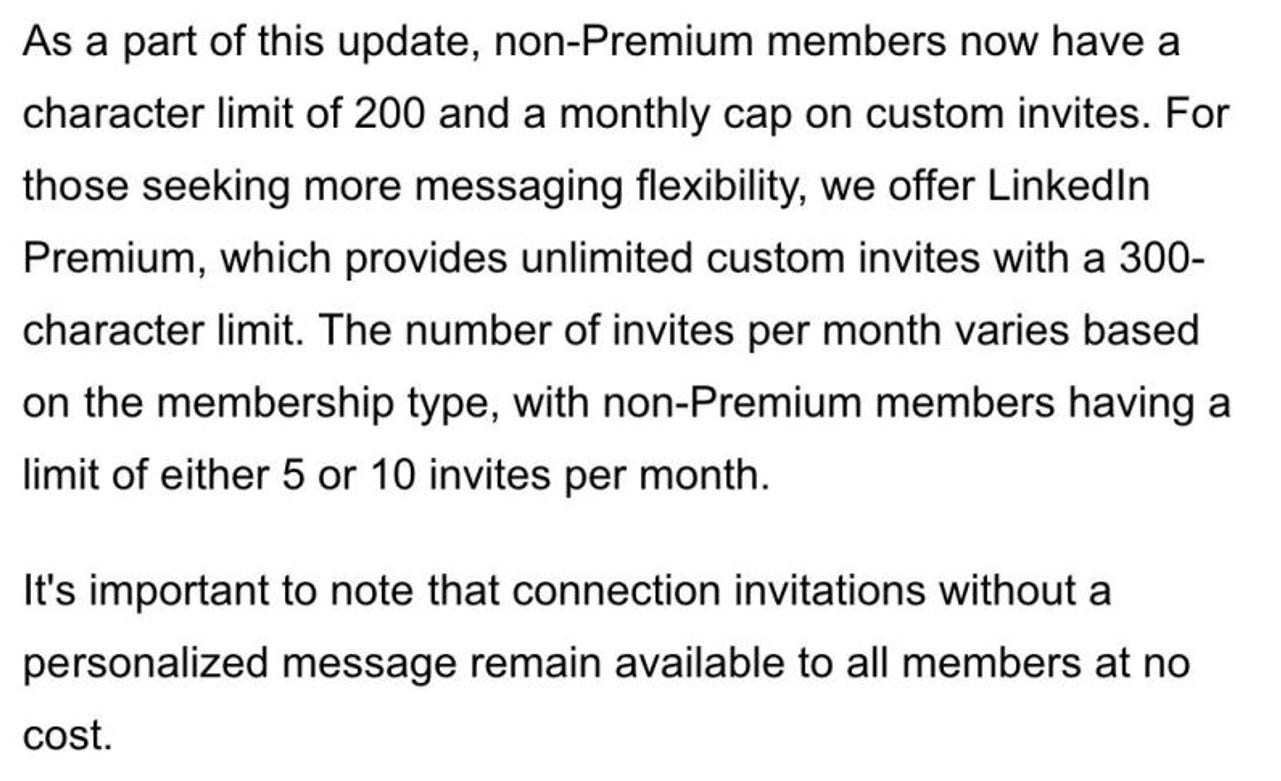How to Overcome LinkedIn's New Restrictions in 2024
Discover effective strategies to overcome LinkedIn's new restrictions. Stay ahead of the game and maximize your professional networking potential.
LinkedIn has long served as the virtual water cooler for professionals - a place to network, explore opportunities, and build personal brands. With over 1 billion members, it remains the dominant platform for digital professional networking.
But lately, LinkedIn has put in some new restrictions, making it tougher for all of us to use it the way we're used to. It began with limitations on the number of LinkedIn connections users can send each week. This was followed by LinkedIn's new restrictions on X-ray searches and limiting the number of connection requests you can send with personalized messages.
Recruiters typically send connection requests with notes to their candidates, either to offer them new positions or if the candidates aren't responding to InMails. Since many recruiters didn't have premium accounts, they used this approach as a cost-free alternative to InMails, and some were quite happy with the results.
Was it effective? It depends on the audience, but it was free.
But here's the thing, recent changes that limit messaging for free account holders are really threatening the value LinkedIn gives to people. For recruiters and job seekers who rely on LinkedIn to find talent or job opportunities, these new restrictions are a big deal. Building relationships and reaching out, which used to be unlimited, now have caps and restraints.
By limiting free accounts and nudging users toward premium subscriptions, LinkedIn could hurt the open networking system that makes it work so well.
In this article, we explore LinkedIn's evolving restrictions, the motivations behind the changes, implications for users, and strategies to navigate this new normal that requires more creativity and selectivity.
No Free Personalized Invitations Left
LinkedIn has imposed strict limits on the number of personalized connection requests and notes that free members can send. Previously, free members had essentially unlimited ability to extend customized invites. However, now there are strict caps in place.
Most LinkedIn users with a free account are now limited to only 5-15 requests per month, along with notes, before they encounter the message "No Free Personalized Invitations Left."
As a result, the previously unrestricted ability to network broadly has been significantly reduced. For some, even harsher constraints are in place - just one invitation with notes per month. Considering recruiters often reach out to dozens of prospects, quotas of 5-15 per month severely reduce efficiency.
Additionally, character limits for personalized notes create further obstacles. Free accounts only permit 200 characters, while Premium members get 300.
Even though there's still a way to reach LinkedIn users for free (check the end of the article), sending connection requests with notes will be limited.
The vastly limited volume and length of messages for non-paying users contrasts sharply with how freely LinkedIn previously enabled networking outreach. For those unwilling or unable to pay, the platform's core value proposition has been critically weakened.
LinkedIn's New Restrictions
LinkedIn's new restrictions on free messaging aim to encourage more “thoughtful” outreach by capping volume. The platform hopes users will become more selective, curbing spray-and-pray mass messages.
Also, by limiting high-volume communication, the aim is to reduce spam and automation risks. This decision is likely to face criticism for hindering broader networking, which is crucial to LinkedIn's value.
The move also serves a financial incentive - nudging users towards paid premium subscriptions. This shift allows LinkedIn to diversify revenue amid challenging conditions. With hiring freezes and layoffs resulting in reduced corporate spending on LinkedIn recruiting products, the platform is now seeking new sources of income.
As corporate customers tighten budgets, LinkedIn is pivoting to monetize more individual subscribers, creating a new monetization path and nudging users toward paid memberships to fill the void left by reduced recruiting income.
I recently spoke with Sheikh Shuvo on his podcast Humans of AI — you should definitely give it a listen!
Impact on Free Members and Recruiters
The recent changes on LinkedIn are really impacting free users, both recruiters and job seekers. It's like we are all being pushed to pay for a membership with the new rules. This could particularly affect job seekers who are trying to connect with hiring managers and recruiters but do not have extra funds for the LinkedIn premium product.
Now, we've got to switch up our game plan: focusing on building quality connections and creating top content instead of merely reaching out to everyone.
For those who cannot afford Premium, it is important to be more considerate when sending connection requests and to leverage our personal brand through content. These changes are kind of nudging us to be more real in our networking and try out new platforms. So, the bottom line is we've got to adapt our strategies to keep up in the networking and job-hunting game.
But you know what? It's not all bad. Less spammy messages mean our real outreach stands out more. It's like networking in a quieter room, where you can actually hear yourself think and, more importantly, others can hear you.
This clean-up could result in less noise and more quality interactions, which is a significant advantage for job seekers. Less inbox competition means our messages have a better chance of being seen, not just buried in a pile of 'Connect with me!' requests. And with scammers getting the boot, LinkedIn is shaping up to be a safer, more reliable place to build your professional brand.
So, while the platform evolves, it's about finding the silver linings. Embrace the change, get creative with how you reach out, and who knows? This might just be the push we all needed to make those LinkedIn connections count for real.
How to Overcome LinkedIn's New Restrictions in 2024
Let me share with you several ways you can “overcome” the new limitations on LinkedIn. Some of these methods are free, while others require payment.
Upgrade to Premium
The most obvious one is getting a Premium LinkedIn account. It is currently the most straightforward way to lift some of the restrictions imposed on free members. The good thing is that you can try it for one month free.
Premium has several different pricing tiers:
Premium Career helps you get hired and get ahead in your professional life
Sales Navigator helps you generate leads and build your clientele
Recruiter Lite helps you find and hire talent
Premium Business helps you get detailed business insights and further expand your business
LinkedIn Learning helps you improve your skills and learn new ones
The Premium Career package provides a good entry point for overcoming the latest connection limits. However, for recruiters who want additional targeting options, Sales Navigator or Recruiter Lite offers the highest level of access and customization for prospecting.
While paid memberships represent an added expense, they currently provide the most leeway for connecting with the right people on LinkedIn without obstruction. As long as your budget allows, Premium opens more doors that would otherwise be closed.
Become a Content Creator
One of the other ways to stand out on LinkedIn without paying or expanding your network is by consistently creating high-quality, engaging content optimized for your target audience. This serves the dual purpose of organically attracting inbound connection invitations while also expanding your overall visibility and reach.
Posting unique insider perspectives, thought leadership content, how-to advice, or commentary around trending news and issues related to your industry allows you to highlight your expertise. You become a trusted voice that people want to network with and learn from.
Some best practices for becoming a successful content creator on LinkedIn:
Develop authority around a specific niche to build a clearly defined audience
Post at least 2x per week to stay on top of the mind
Experiment with different formats like articles, videos, polls to determine what resonates most
Promote your posts through your profile, follower updates, and Groups
Monitor analytics with Shieldapp to continuously refine your approach
The more quality content you put out over time, the more the LinkedIn algorithm rewards your efforts with amplification. This inbound attention circumvents the need to aggressively pursue outbound connection requests. You let your content and thought leadership do the heavy lifting for you.
Note: Before you dismiss it as not for you, it's totally okay. Not everyone wants to be a content creator. But you'd be surprised by the benefits it can bring to your career. Over the last six years, I've ghostwritten for dozens of people, and the impact on their careers and work is real!
Three Other Things You Can Do With Your LinkedIn Profile
You often hear there is a "war for talent." However, I believe we have moved beyond that to a "war of attention." Recruiters are constantly trying to grab the attention of both candidates and other LinkedIn users.
In this environment, creating compelling content can really help you stand out and attract people. When you publish original articles and insights, you position yourself as an industry expert and thought leader in your targeted industry.
This draws talent to your profile rather than you chasing after passive candidates!
Even if you're not a content creator or aiming to be one, you can still turn your LinkedIn profile into a source of candidates without any extra work. Just a few simple tricks can help. Let me show you how to turn your LinkedIn profile into a talent magnet and how to send free InMail messages to your target audience.
Let's start with the free messages!
Sending inMail Messages for Free
LinkedIn offers a clever way to reach almost anyone without requiring a premium subscription. With a savvy strategy, you can send free customized messages to your target audience with a few simple steps.
Here's how:







